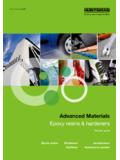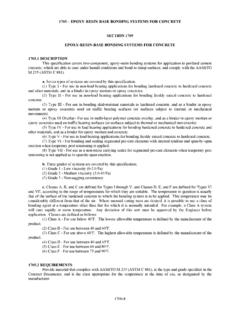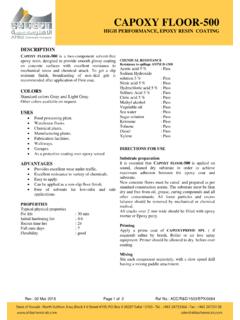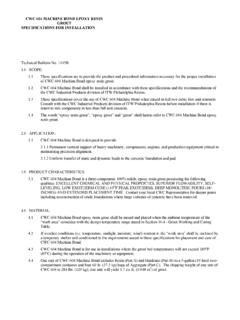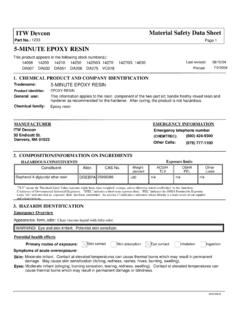Transcription of BASIC TECHNICAL INFORMATION - Raka
1 This epoxy manual is relatively brief and we will try to explain in simple terminology the more BASIC procedures of epoxy gluing, coating and fiberglassing. There are many fine, readily available publications on the market that explain a multitude of advanced techniques using epoxy if this manual does not address your questions. Study the work of at least two authors, for each has his own methods. Some authors may have an affiliation with a certain brand of epoxy , but we can assure you that as a general purpose marine epoxy , ours is second to none. We base this statement on published manufacturers data, our experience and feedback from the many repeat customers that call us daily. Please read this manual carefully and always practice proven techniques. Because epoxy has so much strength, the difference between a good and a bad job may not always be easily recognized. If failure happens, it will come at the worst possible time. The epoxy will be blamed, when the real problem lies in the user not applying the proper mixing or application procedures.
2 If you have a problem, or don't understand something in this manual, don't hesitate to give us a call. THE MANY USES OF epoxy epoxy is not just for boats, but is also excellent for crafts, woodworking, car body repair and hundreds of other home and industrial uses. With epoxy , even a crude patch-up repair can often be stronger than the original design. Though most of our customers are using epoxy in the construction and repair of boats, it also can be an excellent adhesive and filler that bonds well with metals, concrete and some plastics. The production fiberglass boats of today are usually constructed with the cheaper polyester type resin. Polyester resin is used because of its low cost and quicker cure time. Its shorter shelf life is not a problem for large volume users. epoxy resin and hardener on the other hand has an indefinite shelf life, is much stronger, more flexible and is much more waterproof. epoxy resin products not only have a greater bonding strength, but also will bond to a greater number of different materials, including cured polyester resins.
3 It s for these reasons epoxy is used for so many boat repairs. A FEW FACTS ABOUT epoxy PRODUCTS We have tried many of the epoxy products that you see in your local marine and hardware stores, from thick pastes to thin penetrating epoxies. I find, for the most part, they are of high quality and do the job for which they were intended. The problem is that they can be quite exorbitant in cost. We have found that for most boat and shop applications you can custom make your own epoxy products. Take our low viscosity epoxy and mix with one or more of our fillers and you can have an epoxy product tailored to your specific needs. WHAT IS OUR RAKA epoxy SYSTEM? We have several different epoxies with a variety of mixing ratios and curing times. We purchase the BASIC epoxy resins and hardeners in bulk from different manufactures and then blend them to get a finished Raka epoxy . One way, Raka Epoxies are different from many industrial epoxies is that we mix in different and expensive additives that help with better flow and air release.
4 Especially in thin coats, you will notice less pin holing and cratering. The products we ship to our customers with our Raka name will be easy to use and give consistent performance. We can offer lower prices because we don't have distributors and dealers to support so we are free to sell directly to the customer. BASIC TECHNICAL INFORMATION Our main epoxy resin 127 is a low viscosity [thin] liquid. It is basically thick standard grade resin that has been thinned with special additives and reactive diluents. When mixed with its companion hardeners [activator], it will cure to a very tough waterproof plastic. We have several hardeners with different mix ratios and curing times. Raka mix ratios are by volume and not by weight. Please note that our epoxy resins and hardeners have no evaporating solvents, so you will get very little shrinkage compared to polyester resins and some solvent loaded epoxies. Some people prefer a one to one mix ratio because of the simplicity of mixing, Our Table Top System mixes together at one part resin to one part hardener, It is designed primarily to be used as a thick coating epoxy for tabletops, bars and crafts.
5 It is a very clear non blushing epoxy system with a forgiving mix ratio that allows up to 20% off ratio mixing to get harder of softer cures. The high viscosity of Table Top also makes it and excellent general purpose gluing and repair epoxy . Table Top epoxy tends to be more flexible and has somewhat less strength. Pot life is approximately 40 minutes. The hardener 631, is a medium fast curing agent that can be mixed at a ratio of five parts resin to one part hardener. 631 gives the most strength and heat resistance, but you have to give more care to the critical mix ratio and is subject to more blushing. 631 is not recommended for clear coating. Our best selling hardeners are the 610 which is very fast curing and the 606 which is slow curing. They are mixed at a ratio of two parts resin to one part hardener. The two to one ratio epoxies are probably the most popular because they give a good compromise in ease of use, are low blushing and have good overall physical properties.
6 I ll give a brief description of our two to one epoxies because these are what our customers most often request. Depending on the job requirements, you can choose a fast or slow hardener or a combination at no extra cost. At 77 degrees [F.] the pot life (using 3 mixed ounces) of the fast hardener-resin mix is about 8 minutes. Three ounces of slow hardener would give you about 25 minutes of working time. A mixture using only fast hardener 610, can be used down to 50 degrees F and suing only slow hardener 606, should no be used below 60 degrees. A useful feature of the two hardeners is their ability to be blended together to customize a cure time for your particular requirements. We recommend when working under 70 degrees to use a blend of hardeners if you want a working cure within 24 hours. The majority of our customers divide their purchase of hardeners into equal amounts of slow and fast. When epoxy systems are described scientifically you will hear frequently used terms such as hardness, flexibility, impact strength, resiliency and modulus, etc.
7 These are measurements of physical properties. You must be aware that you can't have all the best properties in any single epoxy . A good characteristic in one area is likely to give you a poorer showing in some other area. When we selected our Raka system epoxies, the prime considerations were to get good general purpose boat building and woodworking characteristics. One of the outstanding qualities of our epoxy is that the mixed resin and hardener has a lower viscosity than some other epoxy systems. This allows deeper penetration into the wood and very thorough saturation when wetting out fiberglass cloth. Bubbles that are introduced when mixing dissipate very well to give you a smoother unblemished coating. A thinner mix also allows easier mixing and a higher loading of the many fillers that are available. An example would be loading your epoxy with a higher proportion of micro balloons to achieve easier sanding of the cured epoxy . SAFETY Needless to say, epoxy should be stored in a safe manner, so that anyone, especially children cannot ingest it or get it on their skin.
8 Most people, even those who frequently work with epoxy , do not have any health problems associated with epoxy use. Hardeners are generally more caustic than the resins. If splashed in the eyes, wash out with warm water for several minutes and see a physician. Some users can, over time, develop some skin sensitivity. This is basically an allergic reaction, so stay away from epoxy for awhile. It's recommended to use eye and skin protection at all times when handling epoxy . Do not use chemical solvents to remove epoxy from your skin. Use a waterless hand cleaner. Uncured epoxy resin and hardener is considered a toxic substance, and must be disposed of in an approved manner. epoxy resin and hardener have a very low flammability, but keep in mind that many of the thinning and cleanup solvents such as acetone are flammable and explosive. Keep your mind on the job. See a physician if any health problems develop. MIXING The different Raka epoxy resins and their companion hardeners are engineered to be mixed in a precise way using a certain volume or weight of resin for each volume or weight of hardener.
9 Some of our manufacturer s specifications give the mixing ratios by weight and some by volume. We feel that mixing by volume is simpler and the mixing instructions on our labels specify using volume measurements. In some cases we round off the exact scientific mix ratio to avoid confusion. Correct mixing volumes can be obtained by the use of measuring cups or by the use of our pumps. Before starting any project, check the pumps for metering accuracy and also check your measuring cups as many cheap cups and pots have inaccurate marks. In a clean pot, mix thoroughly in a non beating motion and not too fast as you will introduce air bubbles. Make sure that the liquid that slops up on the side of your bowl and on your mixing tool gets mixed also. Ideally you will pour the mixed epoxy from the first pot into another container and mix again for the most consistent mixing of all the hardener and resin. This may be extreme and too time consuming for most people but will insure a more consistent mix.
10 If you plan to add any fillers, do so only after completing your initial mixing. Mixed epoxy that is in a mass can heat up and become unworkable very fast. Experienced users work with small batches so there is less waste. It is important to remember that epoxy applied in a layer thicker than 1/8 inch may produce enough heat to damage the substrate or cause the epoxy to foam ( especially of concern when using fast hardener under warm conditions). Immediately after mixing (especially when using the fast hardener), spread the epoxy out on a flat surface in a larger container (a plastic plate works fine). In some cases, if you want a faster set up and cure time it is better to leave the mixed epoxy in its pot for a few minutes so it will get a chance to heat up. The epoxy curing process depends on the heat from it's own reaction and the ambient temperature. You will have to experiment to understand each epoxies properties. I want to emphasize the importance of proper mixing.
